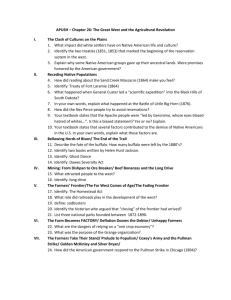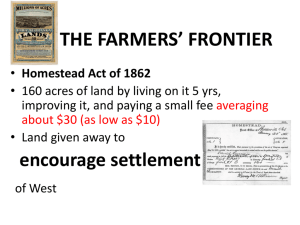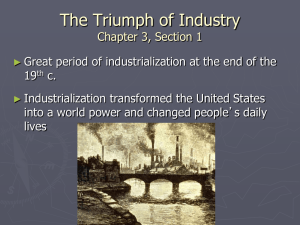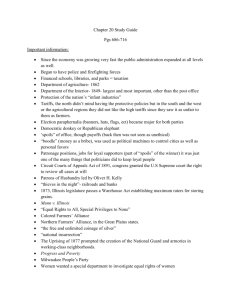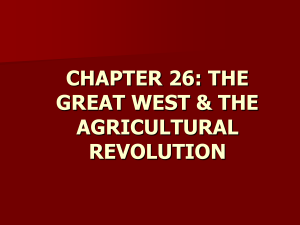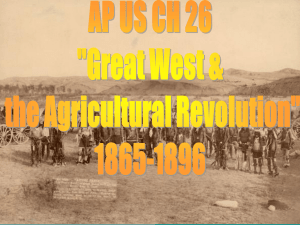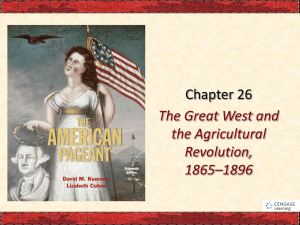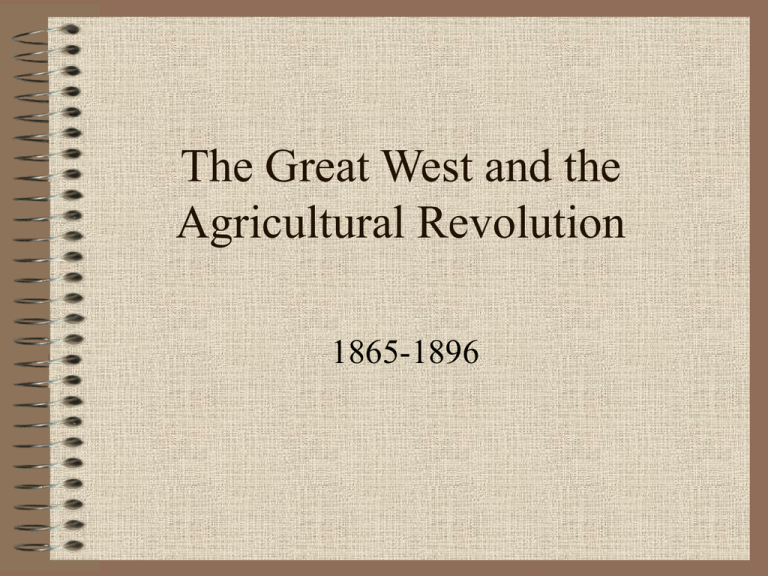
The Great West and the
Agricultural Revolution
1865-1896
Culture Clash on the Plains
• 1860—Native Americans numbered about
360,000
– stood in the path of white pioneers
• White settlers undermined Indian culture
– Spread diseases like cholera and smallpox
– Put further pressure on declining buffalo herds
– Warfare intensified among tribes for hunting
lands
Pacifying the Plains Indians
• Fort Laramie (1851) and Fort Atkinson (1853)
– Marked beginnings of reservation system
– Established boundaries for territory of each tribe
• Treaty makers misunderstood Indian culture
– “chiefs” and “tribes” fictions of white imagination
– Native Americans usually recognized no authority
outside immediate family
– Idea of nomadic culture alien to concept of defined
territory
“Great Sioux Reservation”
• Dakota Territory
• Gave up ancestral land for promises to be
left alone and provided with food, clothing,
and other supplies
– Officials palmed off moth-eaten blankets,
spoiled beef, and defective
provisions
Indian Wars
• Sand Creek, Colorado, 1864
– Colonel Chivington’s militia massacred 400 Indians
who thought they were promised immunity
• 1866, Bozeman Trail Construction
– Sioux war party attempted to block construction
– Ambushed Cptn. Fetterman’s command of 91 soldiers
and civilians in Wyoming’s Bighorn Mountains
– Left no survivors
• 1868 Treaty of Fort Laramie:
– Gov’t abandoned Trail
General George A. Custer
• 1874: led “scientific” expedition into Black
Hills
– Announced he discovered gold
– Sioux took to warpath
• 1876: Battle of Little Bighorn
– Custer and 264 men completely wiped out by
Sioux led by Sitting Bull
– US Army hunted down Indians involved in
following months
Fire and Sword Policy
• Finally ghettoized onto reservations where
they could have cultural autonomy but
were dependent on government
• Cheaper to feed than fight
• Ignored to death for generations
• Brought down by railroad, disease, alcohol
and virtual extermination of buffalo
Bellowing Herds of Bison
• 1865: 15 million grazing in the West
– Food supply of railroad workers
• Massacre of herds began with building of
railroads
– Slain for hides, choice cuts, and amusement
• Fewer than 1000 alive by 1885 with danger
of complete extinction
End of the Trail
• 1880s saw stirring of national conscience
• Helen Hunt Jackson
– A Century of Dishonor chronicled record of
government ruthlessness in dealing with Indians
• Humanitarians wanted to treat Indians kindly
• Hard-liners insisted on current policy of
containment and brutality
– Neither respected the culture
Dawes Severalty Act 1887
• Wiped out tribal ownership of land and set
up individual family heads with 160 acres
• Would receive citizenship after 25 years
– 1924—citizenship granted to all
• 1879: Carlisle Indian School, PA
– Separated children from families
– Learned white values and customs
– 1890s expanded network of boarding schools
Mining
• 1858: Discovery of gold in Colorado
• 1859: Comstock Lode in Nevada
– $340 million mined from 1860-1890
• Transformation in mining industry
– From independent “dishpanners” to
mechanized corporations
– Brought in costly machinery and trained
engineers
Mining Opportunities
• Women found some opportunity running
boardinghouses
– Won vote in Wyoming (1869), Utah (1870),
Colorado (1893) and Idaho (1896)
• Helped fund Civil War, the building of
railroads, and intensified conflict between
whites and Indians
Beef Bonanzas
• Problem of marketing steer solved with
transcontinental railroads
– Cattle could be shipped to stockyards and then
meatpacking factories
– Refrigerator cars perfected transportation
• “Long Drive”
– Cowboys drove herds numbering in thousands over
plains to reach railroad terminals
– Drive profitable as long as grass was available &
escaped Indians, stampedes, and other hazards
– 1866-1888: 4 million steer moved
Unmaking of the Long Drive
• Rails that brought cattle east returned with
homesteader and sheepherder
• Built barbed-war fences too numerous to
be cut down
• Winter of 1886-87
• Overexpansion and overgrazing
Homestead Act of 1862
• Allowed settler to acquire as much as 160 acres
by living on it for five years, improving it, and
paying $30
– Land given away to encourage rapid filling of West
• Corporations used “dummy” homesteaders to
grab best land containing timber, minerals, and
oil
– “improved” land by building 12 X 14 dwellings—in
inches, not feet!
Prairie Geography
• Windswept, mostly treeless, tough sod
– Once broken, land proved fruitful, with settlers
building homes from sod
• Pushed onto marginal lands beyond 100th
meridian
– So little rain fell that agriculture needed
massive irrigation
– “dry farming”—method of frequent shallow
cultivation that created finely pulverized
surface
Kansas emigrants
Kansas emigrants
The railroads provided would-be "sodbusters" with transportation to get to the
land that was being opened for settlement. (Kansas Collection, University of
Kansas Libraries)
Copyright © Houghton Mifflin Company. All rights reserved.
Great American Desert Blooms
• Began to plant drought-resistant grains like
sorghum
• Barbed wire, invented by Glidden in 1874,
built fences on treeless prairies
• Federal financed irrigation projects
– 45 million acres in 17 states
Far West Comes of Age
• 1889-1890: Congress admitted 6 states
– North & South Dakota, Montana, Washington, Idaho,
Wyoming
• Made available to settlers vast stretches of land in
Oklahoma
– April 22, 2869, Oklahoma opened
– 60,000 inhabitants by end of the year, made into a
territory
– 1907—became the “Sooner State”
Fading Frontier
• 1890: superintendent of census declared
frontier to be closed
– Frederick Jackson Turner’s “The Significance
of the Frontier in American history (1893)
• Establishment of national park system
– Yellowstone in 1872, Yosemite & Sequoia in
1890
“Safety Valve”
• Theory stated that during hard times, the
people turned to farming
• Actuality:
– Few moved out of cities during depressions
– Most did not know how to farm or were
unable to raise the money for equipment
– More moved from cities like Chicago, Denver,
and San Francisco than eastern cities
Farm Becomes a Factory
• Large-scale farmers tied to banking,
railroads, and manufacturing
– Needed expensive machinery to plant and
harvest crops (twine binder and combine)
• Mechanization drove many farmers off
their land, increasing ranks of factory
workers
Deflation Dooms Debtor
• Low prices and deflated currency chief
worries of farmers
– Not enough money to go around
– The more they grew, the lower the prices,
driving them deeper into debt
• Growth of tenancy over ownership
– 1880—1/4 farms operated by tenants
Unhappy Farmers
• Grasshoppers, boll weevils, floods, and droughts
wreaked havoc on farmers
• Gouged by farmers from local to federal levels
– Land overassessed
– No protection on world market
• In the grip of railroads
– Freight rates high, sometimes lost less if burned crops
for fuel
Farmers Take Their Stand
• National Grange of the Patrons of Husbandry
(1867)
– Enhanced lives of farmers socially, educationally,
fraternally
– 1875 claimed 800,000 members
– Raised goal from self-improvement to improvement of
farmers’ plight
– Enjoyed political success in Illinois, Wisconsin, Iowa,
and Minnesota
– Strove to regulate railway rates and storage fees
Greenback Labor Party
• 1878—polled 1 million votes and elected
14 members to Congress
• 1880: ran General James B. Weaver as
presidential candidate
– Old Granger and favorite of Civil War
veterans
– Polled 3% of popular vote
Populism
• People’s Party emerged out of Farmer’s
Alliance in 1890s
– Nationalizing railroads, telephones, telegraphs
– Graduated income tax and “subtreasury”
– Free and unlimited coinage of silver
• Ignatius Donnelly (MN) elected to
Congress 3 times
• Mary Elizabeth Lease
Coxey’s Army
• “General” Jacob S.
Coxey
– Set out for DC in 1894
with supporters
– Wanted gov’t to
relieve unemployment
– Arrested for walking
on the grass
Coxey's Army
Coxey's Army
Jacob Coxey's "army" of the unemployed reaches the outskirts of Washington,
D.C., in 1894. Note the new electrical or telephone poles. (Library of Congress)
Copyright © Houghton Mifflin Company. All rights reserved.
Pullman Strike
• Pullman Palace Car Company hit hard by 1893
depression
– Cut wages by 1/3, but did not cut rent at company
town
• Workers struck and held up traffic from Chicago
to Pacific Coast
• Crushed by federal troops
– First time government used injunction to break a strike
– Workers held in contempt imprisoned w/out jury trial
King Debs
King Debs
This famous cartoon about the Pullman
strike, originally published July 14,
1894, in Harper's Weekly, shows Eugene
Debs, head of the American Railway
Union, sitting atop a railway bridge that
has been turned to cut off all rail traffic.
The railroad cars behind him are labeled
"fresh vegetables," "beef," and "fruit," to
emphasize the perishable nature of the
products that could not be delivered, and
others are identified as "U.S. Mail." In
the background, factories have "closed"
signs on them. This cartoon, and others
like it, helped to mobilize opinion
against the strikers. (Library of
Congress)
Copyright © Houghton Mifflin Company. All rights reserved.
Election of 1896
• Republican candidate
• Democratic Candidate
– William McKinley
– Leaned towards hardmoney policy
– Declared for gold
standard
– Largely creature of
Marcus Hanna
– Hanna believed in
“trickle down” effect
– William Jennings
Bryan
– Plea for silver
– Inflation through
unlimited coinage of
silver
– Caused rift with “Gold
Bug” Democrats
“Cross of Gold” Speech
• “We will answer their demands for a gold
standard by saying to them: ‘You shall not
press down upon the brow of labor this
crown of thorns, you shall not crucify
mankind upon a cross of gold.’”
– William Jennings Bryan
July 1896
Populist Dilemma
• Democratic majority
took their platform for
silver
• Endorsed “fusion”
with Democrats and
Bryan for president,
sacrificing identity
Election of 1896 Results
• McKinley triumphed
– 271 to 176 electoral votes
– 7,102,246 to 6,492,559 popular votes
• McKinley carried populous East and the
upper Mississippi River valley
• Bryan’s states included South and West
Consequences
• Heralded advent of new era in politics
– Resounded victory for big business, big cities,
middle-class values, financial conservatism
• Heralded Republican grip for next 16
years, and for all but 8 of next 36
– Accompanied by diminishing voter
participation, weakening of parties, and fading
issues of money and civil-service reform
– Replaced by concern for industrial regulation
and welfare of labor
Republican Stand-pattism
Enthroned
• Tariff issue rose to the front
– Wilson-Gorman Tariff not raising enough
revenue
– 1897: Dingley Tariff Bill (46.5%)
• Prosperity began to return in 1897
• Gold Standard Act of 1900 established
backing of paper money by gold

